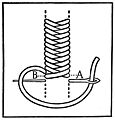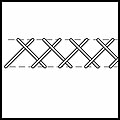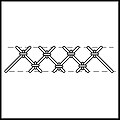Cross stitches



Cross stitches in
.Applications
Cross stitches were typical of 16th century
Herringbone, fishbone, Van Dyke, and related crossed stitches are used in crewel embroidery, especially to add texture to stems, leaves, and similar objects. Basic cross stitch is used to fill backgrounds in Assisi work.
Cross stitch was widely used to mark household linens in the 18th and 19th centuries, and girls' skills in this essential task were demonstrated with elaborate
Variants
Common variants of cross stitch include:[3][4]
- Basic cross stitch
- Long-armed cross stitch
- Double cross stitch
- Italian cross stitch
- Basket stitch
- Leaf stitch
- Herringbone stitch
- Closed herringbone stitch
- Tacked herringbone stitch
- Threaded herringbone stitch
- Tied herringbone stitch
- Montenegrin stitch
- Trellis stitch
- Thorn stitch
- Van Dyke stitch
The most famous are Italian cross embroidery, long arm cross embroidery, and Black Mountain embroidery.[5][6] Italian cross embroidery and Montenegrin embroidery are reversible, which means that the work looks the same on both sides.[7][8][9] These styles are a little different from regular cross stitch embroidery. These more intricate stitches are rarely used in traditional embroidery, but they are still used to recreate historical works of embroidery or by creative and adventurous embroiderers. Double cross embroidery, also known as Leviathan embroidery or Smyrna cross embroidery, combines cross embroidery vertically.
Berlin Woolwork and similar stitches petit point are reminiscent of the heavily brushed, luxurious styles of cross-stitch embroidery, and sometimes paper-printed diagrams are also used.[10]
Gallery
-
Basic cross stitch as worked in embroidery
-
Long-armed cross stitch
-
Double cross stitch
-
Italian cross stitch
-
Basket stitch
-
Leaf stitch
-
Herringbone stitch
-
Tacked herringbone stitch
-
Tied herringbone stitch
-
Montenegrin stitch
-
Thorn stitch
-
Trellis stitch
-
Van Dyke stitch
See also
Notes
- ISBN 0-8212-2621-5, p. 181
- ISBN 1-85177-126-3
- ^ Gillow and Sentance: World Textiles, p. 180-183
- ISBN 0-89577-059-8, p. 38
- ^ "A Stitch in Time: Two-Sided Italian Cross-Stitch". pieceworkmagazine.com. Retrieved 2023-11-03.
- ^ "Assisi Embroidery and Assisi Embroidery Patterns". www.needlepointers.com. Retrieved 2023-11-03.
- ^ "Two-sided Italian cross stitch". rsnstitchbank.org. Retrieved 2023-11-03.
- ^ "History of Cross-Stitch Embroidery". www.heartfuldiamonds.com. Retrieved 2023-11-03.
- ^ "60+ different types of hand embroidery techniques". sewguide.com. Retrieved 2023-11-03.
- ^ "Berlin woolwork". www.britannica.com. Retrieved 2023-11-03.
References
- Caulfield, S.F.A., and B.C. Saward, The Dictionary of Needlework, 1885.
- Enthoven, Jacqueline: The Creative Stitches of Embroidery, Van Norstrand Rheinhold, 1964, ISBN 0-442-22318-8
- Reader's Digest, Complete Guide to Needlework. The Reader's Digest Association, Inc. (March 1992). ISBN 0-89577-059-8
- Lemon, Jane, Metal Thread Embroidery, Sterling, 2004, ISBN 0-7134-8926-X, p. 112
- Levey, S. M. and D. King, The Victoria and Albert Museum's Textile Collection Vol. 3: Embroidery in Britain from 1200 to 1750, Victoria and Albert Museum, 1993, ISBN 1-85177-126-3














